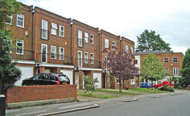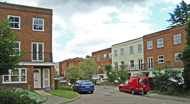Terminal care. Later, maternity.
St Teresa's Home opened in 1938 as a home providing pre- and post-operative care for women suffering from cancer or from advanced heart disease. The Home had been founded by the Mother Superior of the Convent of St Anne, who had used £17,000 of her personal fortune to found the Convent and the Home, and also acted as Matron of the Home. The Home's Patron was the Archbishop of Southwark.
The Home initially had 20 beds, a chapel and a garden. Although it was run by the Sisters of St Anne, a Roman Catholic order, patients of any or no denomination were accepted. Most were of limited means and so were charged only £2 2s (£2.10) a week, which was soon increased by 2 shillings to £2 4s (£2.20) a week. They were referred from the London teaching hospitals - St Bartholomew's, St Mary's, St Thomas', Westminster, St George's, the Middlesex, the Royal Free and the London.
During WW2 a Children's Ward was opened in July 1942 at the request of Dr Charles Pinckney, the Honorary Physician to the Victoria Hospital in Tite Street (the buildings of which had been severely damaged by bombs and were unfit for in-patients). A small side ward was also built to provide an additional 4 beds. The Home then had 31 beds, including 10 cots. A portable X-ray machine was also obtained and an operating theatre installed.
In 1943 the Home had 35 beds, 22 of which were for adult female patients. The Children's Ward was kept strictly apart from the cancer cases. The weekly charge for an in-patient had risen to £2 5s (2.25), including drugs and dressings. Adult admissions for that year included 86 cancer patients, 7 heart cases and 6 others of various causes. The children mainly suffered from upper respiratory disease (41 cases), glands (14 cases), otitis media (13 cases) or had been admitted for observation (36 cases).
The Home suffered bomb damage in 1943.
In 1945 the Sisters wished to open a pavilion for patients with advanced tuberculosis, but there were local objections and the plan was unsuccessful.The Home was disclaimed from the NHS in 1948 and remained independent. It had 28 beds for cancer patients and 10 beds for children with acute disease, which were used by the Victoria Hospital and St George's Home in Chelsea. Adult patients were referred from the Middlesex, Westminster and Brompton Hospitals, and the Sisters expressed an interest in accepting TB cases from the LCC.
In 1950, when its original funds were almost exhausted, the Home received a capital grant of £5,000 from the Ministry of Health towards the cost of converting the buildings into a maternity home and building a new extension. The cancer patients were moved to another hospital, as were the children, and the Home closed for six months in May to enable the building works to ahead.
St Teresa's Maternity Hospital was officially opened by Sir William Gilliatt, gynaecologist to the Queen, in January 1951. It had been extended to have 40 beds, 30 of which were in wards of not more than 6 beds each. Twenty of these beds were on contract to the South West Metropolitan Regional Hospital Board and the remaining 10 were for non-NHS patients. There were also 3 semi-private wards of 2 beds each and 4 private patient rooms (private patients were charged from 8 to 12 guineas (£8.40 - £12.60) a week).
An apartment had also been provided for the Resident Medical Officer. The nursing staff consisted of 8 midwives, 1 State-Registered Nurse, 3 Assistant Nurses and 3 nursing assistants (nuns).
By 1954 the Hospital had 42 beds, of which 36 were in the post-war wing and the remainder in the original converted house, which also contained the operating theatre, the kitchen, offices, a creche and non-ward rooms. A lift was installed to serve the existing two floors.
In 1955, when a training programme was established for student midwives, it was decided to build a new wing with 19 beds. Work began in November 1955 and was expected to be completed by June 1956.
The new 2-storey building was officially opened on 5th December 1956 by Sir Horace Evans, physician to the Queen. It had cost £3,000 and contained two public wards of 5 and 10 beds each and 4 single private patient rooms. By this time the Hospital was working almost entirely for the Regional Hospital Board. All the maternity nursing homes in the Wimbledon area had closed as the patients were unable to pay the high charges (19-20 gns - £19.95-£21.00) a week. Since the Sisters of St Anne worked without salary, the Hospital was able to charge 11-13 gns (£11.55-£13.65) a week.
In May 1957 the Hospital had 60 beds, 18 of which were for private patients. Most of the patient accommodation had been built since the war. The Hospital by now derived 80% of its income from the South West Metropolitan Regional Hospital Board. It charged notional salaries for the Sisters (who were not paid) and received from the Board actually more than the whole running costs of the Hospital. The remaining 20% of the income was from private patient payments, voluntary gifts and interest on investments.
In November 1957 new equipment was installed in the main kitchen.
In 1957 plans were made to replace a 'temporary' building, erected before the war, which needed to be demolished on the grounds of safety. It housed the canteen and the Almoner's office, but was too small and could not be adequately heated.
In April 1959 the new wing was officially opened by Lady Dorothy Macmillan, wife of the Prime Minister. It was the third major extension of the Hospital to be completely during the decade. The new Out-Patients Department, which had opened in November 1958, also contained a new Dispensary-cum-Pathology Laboratory (which had previously been too small, but was now well-equipped), offices for the Almoner and Medical Records and a canteen for mothers attending clinics. A suite of the higher standard expected in purely maternity hospitals had been installed in the operating theatre. The X-ray Department contained a unit, bought secondhand from the Royal National Orthopaedic Hospital, and a darkroom. All West Indian mothers (some 50% of patients) had a chest X-ray, as they were particularly susceptible to TB, otherwise this was only done in special cases. The building also contained a ward of 4 beds on the ground floor, an apartment for a second Resident Medical Officer, a large linen storeroom and a Refectory for the Nursing Sisters (who had been using the converted coach house).
In 1959 the Hospital's income was £37,785, while its expenditure was £40,495. It had no legacies and its Nursing Sisters received no salary. It had 60 beds, 18 of which were private or semi-private. The average occupancy of beds was 45.
In 1960 patients were referred from St James Hospital in Balham, when its 40 maternity beds were closed to make room for acute surgery patients.
The weekly charge for a private patient room in 1960 was 18 gns (£18.90), with a consultation fee of 5 gns (£5.25).
By 1961 the Hospital had 5 labour theatres and a 10-bedded ward where General Practitioners (GPs) could be in charge of delivering of their own patients, but have all the specialist services at their disposal. All the wards were considered to be particularly bright and cheerful, with large windows and plenty of space. In November the two apartments for the Resident Medical Officers and the kitchen were improved for £1,500.
By 1963 the Hospital was in straitened financial circumstances.
In 1967 the South West Metropolitan Regional Hospital Board decided to withdraw its grant of £77,000 a year on the grounds that a new maternity unit of 35 beds was being made available at Queen Mary's Hospital, Roehampton (and that it was now government policy to locate such beds in a district general hospital for safety reasons).
Despite a petition of 35,000 signatures and a 'march of prams' to the House of Commons in protest of the withdrawal of the subsidy, the Board carried out its plan and, from January 1968, NHS patients were referred to Queen Mary's Hospital. The Hospital, now deeply in debt due to its latest extension, refused the offer of an alternative contract from the Board to provide care for geriatric and chronically sick patients on the basis that converting the buildings for such a purpose would be prohibitively expensive.
By 1971 the Hospital was able to offer a limited maternity service following a fund-raising campaign by the 300-strong League of Friends of St Teresa's Hospital. The League consisted of local people who gave up their time to do clerical work, help in the linen store, man the switchboard, help in the hospital shop, etc. Under an Endowment Scheme, facilities were made available to the patients of 4 Wimbledon GPs for a minimal fee. The Sisters, of course, remained unsalaried.
In May 1986 the Sisters of St Anne announced their intention to sell the Hospital because of changing needs in the community.
Present status (August 2008)
The Hospital buildings have been demolished and their site is now occupied by Southridge Place, an estate of 23 three-storey houses, which was built in 1987.
The Sisters of St Anne remained in the neighbourhood and established St Teresa's Home for Elderly in Lansdowne Road.


Southridge Place.
(Author unstated) 1956 St Teresa's Hospital, Wimbledon. British Medical Journal 2 (5008), 1557.
Flood CM 1967 St Teresa's Hospital. British Medical Journal 2 (5554), 767-768.
O'Sullivan JV 1961 General Practitioner maternity beds in a large general hospital. British Medical Journal 2 (5263), 1349-1350.
Smallwood RIL 1967 St Teresa's Hospital. British Medical Journal 2 (5543), 54-55.
http://archive.catholicherald.co.uk (1)
http://archive.catholicherald.co.uk (2)
http://archive.catholicherald.co.uk (3)
http://archive.catholicherald.co.uk (4)
http://archive.catholicherald.co.uk (5)
http://archive.catholicherald.co.uk (6)
http://archive.catholicherald.co.uk (7)
http://archive.catholicherald.co.uk (8)
http://hansard.millbanksystems.com (1)
http://hansard.millbanksystems.com (2)
http://hansard.millbanksystems.com (3)
www.merton.gov.uk (1)
www.merton.gov.uk (2)
www.merton.gov.uk (3)
Return to home page